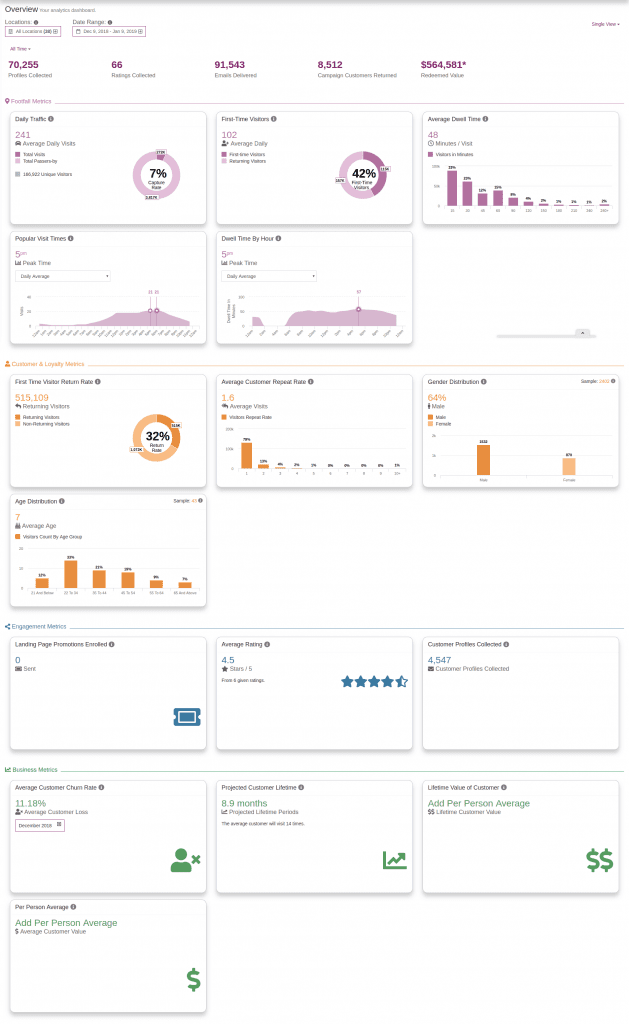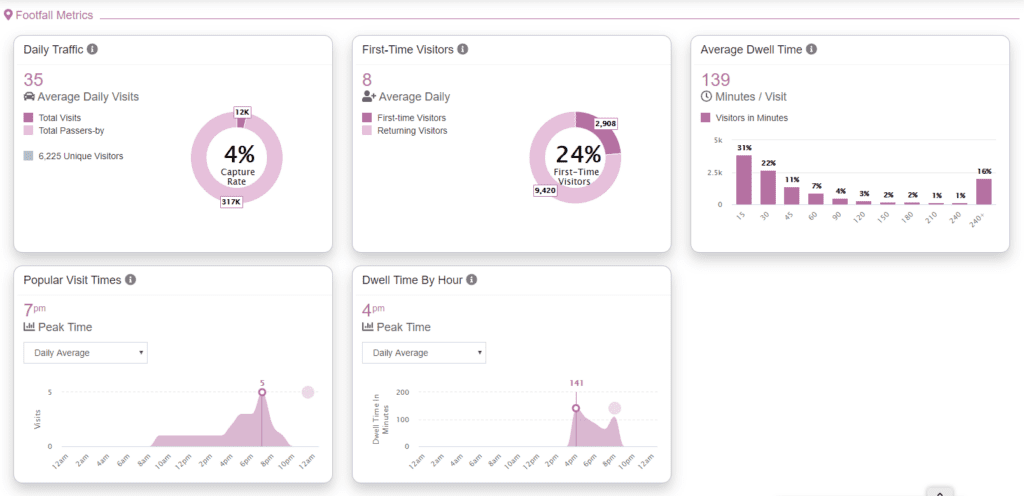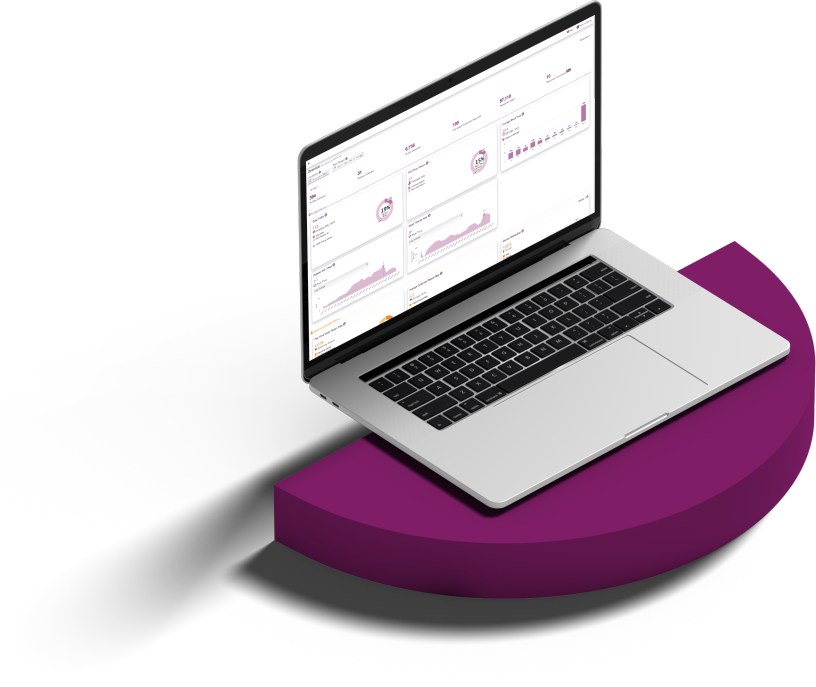What is Customer Analytics?
Firstly, customer analytics is key to any successful marketing campaign and operational strategy. The ability to measure, collect, and monitor customer behavior and customer data before and after marketing and operations initiatives is the difference between a successful or unsuccessful strategy.

For brick-and-mortar establishments, obtaining the necessary data has, until now, been somewhat problematic.
Fortunately, with a WiFi analytics platform, brick-and-mortar marketers can enjoy the benefits of detailed contact, demographic, and behavior data on each and every one of their customers or see aggregate trends at their locations for all customers, whether they log into WiFi or not.
 What is Customer Analytics?
What is Customer Analytics?
Customer analytics, also known as consumer analytics, refers to the collection of customer contact data, demographic, and behavioral data.
Given that, targeted marketing, customer relationship management, tracking attribution, and making data-driven operational decisions are all appropriate uses for the data.
So, Bloom Intelligence has created the opportunity for offline businesses to utilize their WiFi access points to gather, analyze, and react to customer behavior data in real-time.
The Bloom platform captures detailed location analytics and behavior data that previously couldn’t be seen.
For example, you’ll see customer dwell times, the number of first-time visitors, first-time visitor return rate, and popular visit times.
Your analytics platform will begin building a detailed customer profile for each guest when a user logs into your WiFi access point and or other customer data capture points.
Then, this data can be used for segmenting and marketing to different groups with different marketing messages.
Then Bloom’s presence analytics will show you the impact or ROI of all campaigns since Bloom knows when a customer receives a message, returns to the location(s), and redeems the offer at the location.
Likewise, if you enter your PPA or integrate your point of sales, we also show you the tangible ROI of all campaigns.
The Importance of Customer Analytics
Today’s consumers are more connected and empowered than ever.
In short, they have a never-ending stream of information about what to buy, what others are saying, and where to spend their money.
This is why it is so important to understand who your customers are and how they interact with your business.
The higher the understanding of customer buying habits, behavior, and preferences, the more accurately you can respond in your marketing, branding, and messaging.
As a result, you’ll be more successful at delivering attractive, relevant offers, messages, or surveys to the right customers at the right time.
It all begins with collecting comprehensive customer data analytics.
Types of Customer Analytics
Firstly, there are three main types of analytics available when using a WiFi analytics platform: Footfall Metrics, Customer & Loyalty Metrics, and Engagement Metrics.
As has been noted, whether customers log into your WiFi access point or not, Footfall Metrics can be collected.
For example, they include metrics such as average daily traffic, daily first-time visitors, dwell times, visit times, and more.

In addition, you’ll also have access to Customer and Loyalty Metrics.
This analytical data gives you an idea of the demographics of your customers and their loyalty to your establishment. Examples of these metrics include first-time visitor return rates, customer repeat rates, gender, and age distributions.

Useful WiFi analytics platforms also include Customer Engagement & Business Metrics.
These metrics can give you a great understanding of how deep of a connection that exists between your business and your customers. And they can reveal how lucrative that connection is to your business.
You’ll have access to data such as average customer ratings, customer churn rates, customer lifetime values, per-person averages, and more.

Users view these metrics by any date span. Or, they can be compared between two locations or groups of locations.


Using Customer Analytics For Business Growth
In marketing, it may seem as if the more people you reach, the better the results you’ll garner. However, this isn’t necessarily correct.
According to CMO.com, targeted advertisements are, on average, almost twice as effective as non-targeted ads.
For instance, sending out an email about a late-night happy hour may not resonate well with older customers or those who are up early in the morning.
In this case, you wouldn’t want to spend your marketing resources on sending this message to early risers.
So, customer WiFi analytics allow you to do just that.
Certainly, sending a single message to your entire customer list may resonate well with some, but not to all of them.
Remember that the best ROI occurs when your marketing message finds the right audience at the right time.
Therefore, by targeting different messaging to specific segments of your audience, you have a better chance of reaching your marketing goals.

SAVE TIME, INCREASE CUSTOMER LIFETIME VALUES, CREATE NEW CUSTOMERS
What our happy customers
are saying
WiFi Analytics FAQs
What is WiFi Analytics?
WiFi Analytics is the process of collecting & analyzing customer data from WiFi-enabled devices through WiFi access points. As a result, this data is used to create KPI’s around customer behavior at a location such as dwell time or churn likelihood. After that, these KPI’s are used to improve operations, trigger marketing, and track campaign results.
What is Customer Churn?
First, customer churn or customer attrition is the percentage of customers that stopped using your service or going to your locations during a specific period. So, marketers use this data to create marketing campaigns to save at risk customers. Likewise, operators utilize this data to optimize business operations.
How do you track marketing for physical locations?
Marketers of physical locations track performance of their marketing campaigns by using WiFi analytics. To illustrate, location marketers use email addresses of customers that are associated to WiFi-enabled device to track via WiFi access points whether that customer returned to a location from an email or online marketing campaign.
What is Customer Dwell Time?
First, customer dwell time is the length of time a customer stays at your location. For example, in restaurants, it is also called table turn time. Customer dwell time is used to measure the efficiency of their staff of servicing their customers. As a result, this combined with customer satisfaction has a direct correlation to revenue production efficiency of your staff.











